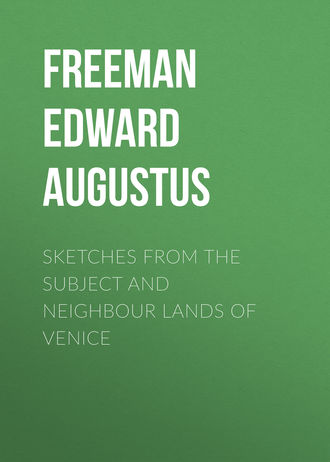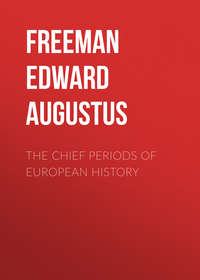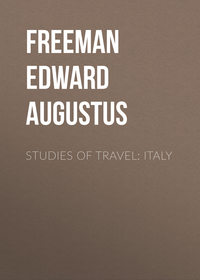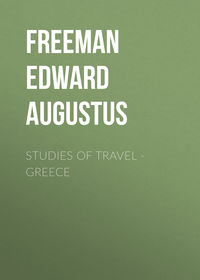 полная версия
полная версияПолная версия
Sketches from the Subject and Neighbour Lands of Venice
Here at last something of no small value has been lighted on. As a matter of architecture, this church is by far the best thing in Cividale. Indeed, as a matter of architecture strictly so called, it is the only thing of any importance. But let the other churches be gone through again, perhaps only with that relief of the mind which follows the discovery of an intelligible clue, yet more when old memories are revived and strengthened by a second visit, and, though they are of no great value as buildings, they are found to be of no small interest in other ways. The Templum Maximum indeed, late and corrupt as is its style, is not without a certain grandeur of internal effect, and it contains more than one object which calls up historic memories. There is the chair which cannot in strictness be called patriarchal, but which was doubtless used by patriarchs when the spiritual shepherds of Aquileia fled from their wasted home to the safer shelter of Forum Julii, and ruled its chief church as provosts. There too on the altar we may see the silver image work of the twelfth century, the gift of one of the two patriarchs who bore the name of Peregrinus. And there too is a wonderful object, the indoor baptistery – for it is more than a font – repaired two years after Charles the Great had added the style of King of the Lombards to his Frankish kingship and his Roman patriciate. We may then believe that, in the columns and round arches of its octagon, we see work of the date when the land of Forum Julii was still the Austria of an independent Lombard realm. Other objects of early days are to be found in even the less promising churches, specially an altar, rich with the goldsmith's craft, which suggests, though it does not rival, the altar of Saint Ambrose at Milan. But first among the treasures of Cividale must rank the precious volume which is still guarded in the treasury of the great church. This is an ancient book of the gospels, now of three gospels only, for some zealous Venetian, eager for the honour of Saint Mark, deemed that the pages which contained his writings were out of place anywhere except in the Evangelist's own city. The highest historical value of the book consists in the crowds of signatures scattered through its margin, signatures of persons great and small, known and unknown, from the days of the Lombard princes to the Empress-Queen of the last age and the Bourbon pretender of the present. When we have grasped the fact that the popular speech of the surrounding district is Slavonic, we are less surprised than we otherwise might be to find that a large proportion of the signatures come from eastern Europe. Among them are a crowd of signatures from Bulgaria, headed by Michael their king. It is for palæographers to judge of the date by the writing. And palæographers say that, of the ancient names, none are earlier than the end of the eighth century or later than the end of the tenth. Otherwise we might have been driven to see in this Michael nothing greater than a fourteenth century king of an already divided Bulgaria. But the great Simeon of an earlier day left a son Michael, a monk, who left his monastery to strive vainly for his father's crown. Yet, if the witness of wise men as to the dates of the writing may be trusted, it must be either the signature of this Michael or else an utter forgery. But the unenlightened in such matters asks how the signatures of men of so many lands and ages got there. Did those whose names were written – for of course few, if any, would write them themselves – come to the book, or did the book go to them? The earlier signatures at least are said to be the names of reconciled enemies who took the holy book to witness that their enmities were laid aside. This we can neither affirm nor deny, but it surely cannot apply to all the signatures in the book. The treasury contains other ancient books, and other objects which are well worth notice, but this strange and precious relic is the chiefest of them all.
Altogether then there turns out to be a good deal to see on the site which once was Forum Julii. What is to be seen is perhaps not exactly of the kind which the traveller may have fancied in his dreams. He can hardly have come expecting to find a stately mediæval or modern city. He may have come expecting to find the walls of a Roman city sheltering here and there either Roman fragments or modern cottages. He will find neither of these; but he will find a town whose natural position is far more striking than could have been looked for in the approach from Udine, and whose chief merit is that it shelters here and there, in corners where they have to be sought for, several objects, neither Roman nor mediæval, but of the darker, and therefore most instructive, period which lies between the two.
GORIZIA
1881At Udine and at Cividale we are still in Italy in every sense which that name has borne since the days of Augustus Cæsar. But the fact which may have startled us at the last stage of our course, the fact that a Slavonic tongue is to be heard within the borders of both the old and the new Italian kingdom, may suggest the thought that we are drawing near to parts of the world which are in some respects different from Treviso and the lands to the west of it. We are about to pass from the subject lands of Venice to the neighbour lands. We shall presently reach the borders which modern diplomacy has decreed for the Italian kingdom, seemingly because they were the borders of the territory of the Venetian commonwealth on the mainland. Venice, as Venice, has passed away, but it is strange to see how one of the most artificial of her boundaries survives. The present arrangements of the European map seem to lay down as the rule on this frontier that nothing that was not Venetian can be Italian. The rule is purely negative; no weight at all is given to the converse doctrine that whatever was Venetian should be Italian. Nor is it necessary to plead for any such doctrine, a doctrine which nationality and geography, as well as practical possibility, would all decline to support. Still it is hard to see why the negative doctrine should be so strictly pressed, and why Italian lands should be forced to remain under a foreign dominion, simply because they never came under the dominion of Venice. If any argument grounded in this way on facts which have long since ceased to have a meaning were urged on the Italian side, it would be at once scouted as pedantic and antiquarian. But it would seem that even pedantry and antiquarianism are welcomed when they tell on behalf of the other side. For surely it is the height of pedantry and antiquarianism to argue that, because a land was never numbered among the subject provinces of Venice, it therefore may not be numbered among the equal members of a free Italian kingdom. It is certainly hard to find any other reason, except that the advance of Venice stopped at a certain point, to account for the fact that the dominions of a foreign prince come so awkwardly near to Verona, for the fact that Trent and Roveredo look to Vienna and not to Rome. Such are our thoughts on one line of journey; on our present course the same question suggests itself again. We pass a frontier where it is not at first sight easy to see why any frontier should be there. We journey from Udine to Gorizia, still keeping within the old Lombard Austria, but between Udine and Gorizia lies Cormons, and after Cormons we find ourselves in a new Austria. We speak with geographical accuracy. We might not say, as some would, that we were in Austria if we were at Cattaro or at Tzernovitz, but in the land which we have now entered, we are, not indeed in the archduchy of Austria, but within the circle of Austria according to the arrangements of Maximilian. And in truth we do soon mark a change. We soon come to feel more distinctly than before that we are in a land where more tongues than one are spoken. We may have found out that round about Cividale all is not Italian in speech; but the Slavonic tongue of those parts is modest and retiring. It does not thrust itself into print or show itself flauntingly on doors or windows. But when we pass the border, when we are in the land which is Austrian both in the oldest and the newest sense, the presence of a twofold, even of a three-fold, speech makes itself very clear. At Cividale, if Slavonic was to be heard, it was at least not to be seen. In the city which we next reach, Italian and Slavonic are both to be seen openly, and a third tongue is to be seen alongside of them. Are we to seek here for the justification of the frontier which struck us as artificial and needless? Is the fact that the Slavonic tongue is spoken in or close by the city which we next reach a proof that that city ought to remain outside the Italian kingdom? If so, the argument might be thought to prove too much; it might be thought to prove that Cividale ought not to be counted to Italy any more than its neighbour. But any one who took up this line of argument would hardly be led by it to approval of things as they are. The Panslavist who should go the length of arguing that neither Gorizia nor Cividale ought to look to Rome as its head would hardly argue that either of them ought to look to Vienna.
We have written the name Gorizia; but we have written it with fear and trembling. For we have now reached a city where we have three names to choose from. Shall we say Görz, Gorizia, or Gorici? All three names will be found carefully displayed side by side in public notices. One is tempted, by the analogy of a crowd of Slavonic names in other places, to suggest Goritaz instead of any of them. But Gorici is the Slavonic form as by law established, and to that rule both natives and visitors may do well to bow. In any case there is little doubt that on this spot of many names we have reached a place which, though Italian in geography, though for ages German in allegiance, was in truth Slavonic in origin. A charter of Otto the Third speaks of "una villa quæ Sclavonica lingua vocatur Gorizia." This is the earliest certain mention of the place. There is indeed a document which tells us how in the year 949 Bishop John of Trieste was borne down by many troubles, and how one source of his troubles was a heavy debt to David the Jew of Gorizia. But wise men reject the document which asserts this piece of episcopal mismanagement. And the way in which the place is spoken of in the eleventh century does not sound as if it could have been a spot whose wealth could have drawn Jews thither in the tenth. In any case the Slavonic villa grew into a town and a county of the Empire, and late in the fifteenth century the Counts of Gorizia became the same persons as the Archdukes of Austria. But long after the beginning of that union, the distinction between Austria and Gorizia was still strongly drawn. How much Gorizia still thought of itself, how much its prince still thought of himself in his local character, is made plain by the most prominent feature of the chief building of the place. Over the gateway of the castle is an inscription recording repairs done in the year 1660 by the reigning Count Leopold. That Count bore higher titles, and he does not fail to record them on the stone; but they are recorded in an almost incidental way. Letters boldly cut, letters which catch the eye at some distance, proclaim that the work was done by LEOPOLDUS COMES GORITIÆ. Go near, and you may literally read between the lines, in smaller letters and abbreviated words, that this Count Leopold happened to be also Emperor of the Romans, King of Germany, Hungary, and Bohemia, Archduke of Austria, and – in his own eyes at least – Duke of Burgundy. But here at Gorizia he reigned and built directly as Count of Gorizia, and he proclaimed himself primarily by his local title. In an inscription such things could be done; heraldry hardly admitted of any such ingenious devices. The bird of Cæsar must bear the hereditary shield of the prince who has been chosen to the imperial office, and on that hereditary shield the bearings of the Gorizian county cannot displace those of duchies and kingdoms. While therefore the legend proclaims the doer of the repairs of 1660 as before all things a hereditary local count, the shield proclaims him as before all things a Roman Emperor-elect. Yet one may believe that most of those who pass under the imperial bird over the gateway deem him all one with his bastard likeness over the tobacco-shops. Some may even fail to see that, among the many hereditary bearings of the elective Cæsar, the lion of the Austrian duchy keeps his proper place. That lion is so apt to pass out of sight, men are so ready to cry "Austria" when they see the eagle of Rome, so little ready to cry "Austria" when they see Austria's own bearing, that it may be kind to point out one place where his form and his occasional destiny may best be studied. The true Austrian beast is plainly to be seen on the walls of the Schlachtkapelle near Sempach, and his presence there is explained by the legend, thrilling to the federal and democratic mind, "Das Panier von Oestreich ist gefangen, und ist nach Uri gekommen."
The eagle of Rome over the gateway, in a place where in these regions we look almost mechanically for the lion of Saint Mark, reminds us yet again that we have passed from the subject into the neighbour lands of Venice. And various inscriptions, public and private, bring no less clearly home to our minds that we are in a land of more than one tongue. Of the three names of the town, that by which we have hitherto spoken of it, that which it bears in the earliest trustworthy charter, that which differs by one letter only from its more ordinary Latin shape as seen over the gate, is also the name which the traveller will most frequently hear in its streets and will see universally written over its shops. As far as one can see at a glance, German is at Görz the tongue of hôtels, cafés, public departments of all kinds. Italian is the tongue of the citizens of Gorizia whose shops are sheltered by its street arcades. Slavonic, we conceive, will some day be the tongue of the little children who, in all the joy of a state of nature, as naked as any other mammals, creep, as merrily though more slowly than the lizards, over the grass and stones of the castle-hill of Gorici. Anyhow Gorizia is, like Palermo of old, the city of the threefold tongue. But the place itself is, considering its history, a little disappointing. Nothing indeed is lacking in the way of position. Mountains on all sides, except where the rich plain of the swift Isonzo stretches away to the sea, fence in the city, without hemming it close in as in a prison. One hill is crowned by the castle, whence we look out on another crowned by the long white line of the Franciscan convent, suggesting memories of the banished king who was the last to receive the consecrating oil of Rheims. Houses, churches, villages, are thickly scattered over the plain and the hill sides. The vines and the mulberry-trees, the food of the silkworm whose endless cocoons choke up the market-place, witness to the richness of the land. But there is a strange lack of buildings of any importance in this capital of an ancient county, this resort which boasts itself as the "Nizza Austriaca," the "Oesterreichische Nizza" – in such formulæ the third tongue of the spot is not called into play. A Nizza without any Mediterranean may seem as strange as the Rialto which we saw at Udine without any Grand Canal. But Gorizia as a modern town is not striking. Its best features are the old arcades in some of its streets and markets. Such arcades must be bad indeed to be wholly unsatisfactory, and some of those at Gorizia are very fairly done. But there is no grand church, no grand municipal palace; the castle itself is not what on such a site it ought to be. The castle is the kernel of the whole place. Gorizia is not a hill-town, nor can we call it a river-town. There is the castle on the hill, and the town seems to have gathered at its foot. The castle soars so commandingly over the country round that we wish here, as at Udine, that there was something better to soar than the ugly barrack which forms its uppermost stage. There are indeed better things within Count Leopold's gateway. The outer court is laid out in streets, and contains several houses with architectural features. One, bearing date 1475, with respectable columns and round arches below, and with windows of the Venetian type above, might pass for a very humble following, not of the palaces of Venice or Udine, but of the far nobler pile which is in store for us at Ragusa. A small church too strikes us, with its windows projecting like oriels, one of them indeed rising from the ground. This last, when we enter, proves to be the smallest of side-chapels set on this fashion. In some cities such a small eccentricity would hardly deserve any notice; but at Gorizia we learn to become thankful for rather small mercies.
In the lower town what little interest there is gathers round the pieces of street arcades; the churches go for next to nothing. Yet Gorizia ranks as an ecclesiastical metropolis, and it has its metropolitan church no less than Canterbury or Lyons. Nor is this merely one of those arrangements of the present century which have stripped Mainz and Trier of their immemorial dignity, and which have given us archbishops of such unexpected places as Munich and Freiburg-im-Breisgau. The style of Archbishop of Gorizia is at least several generations older than the style of Emperor of Austria. The church of Gorizia rose to metropolitan rank, at the same time as the church of Udine, when the patriarchate of Aquileia came to an end, and its province was divided between the two new metropolitans thus called into being. But the seat of the modern primacy is hardly worthy of a simple bishopric. There is nothing in the building of any antiquity but a choir, German rather than Italian, and of no great antiquity either. The rest of the church is of a gaudy Renaissance; yet it deserves some notice from the boldness of its construction. It is designed, within and without, of two stories: that is, the upper gallery is an essential part of the building. The principle is the same as in Saint Agnes and Saint Laurence at Rome, and as in German churches like the Great Minster at Zürich; but the feeling is quite different. Still, if a church is to be built in a Renaissance style and to receive two sets of worshippers, one over the heads of the other, it must be allowed that the object is thoroughly attained in the metropolitan church of Gorizia, and its architect is entitled to the credit of having successfully grappled with the problem immediately set before him.
Gorizia then can hardly claim, on the ground either of its history or its buildings, to rank among cities of the first, or even of the second class. Its natural position far surpasses all that has been done in it, and all that has been built in it. But there is no spot on which men have lived for eight or nine hundred years which does not teach us something, and Gorizia has its lessons as well as other places. It would hardly be worth making a journey thither from any distant point to see Gorizia only; but the place should be seen by any one whose course takes him through the lands at the head of the Hadriatic. Udine, Cividale, and Gorizia are places which have in some sort partitioned among them the position of fallen Aquileia. From the children, we might perhaps say the rebellious children, we must go on to the ancient mother.
AQUILEIA
1875 – 1881We have already, in our course through the lands at the head of the Hadriatic, had need constantly to refer to the fallen city which once was the acknowledged head of those lands, the city whose fame began as a great Roman colony, the bulwark of Italy at her north-eastern corner, and which lived on, after the fall of its first greatness, in the character of the nominal head alike of a considerable temporal power and of an ecclesiastical power whose position and history were altogether unique. We have noticed that, while the cities of this region rise and fall, still even those which fall are not wholly swept away. Aquileia has always lived, though, since the days of Attila, the life of the actual city of Aquileia has been a very feeble one indeed. But though Aquileia, as a city, practically perished in the fifth century, yet it continued till the eighteenth to give its name to a power of some kind. Its temporal position passed to Forum Julii, and Udine succeeded to the position alike of Forum Julii and of Aquileia. But the patriarchs grew into temporal princes, and their style continued to be taken from Aquileia, and not from Forum Julii or Udine. On the ecclesiastical side, the patriarchal title itself arose out of a theological and a local schism. And, while the bishops of Aquileia thus rose to the same nominal rank as those of Constantinople and Alexandria, they had, as the result of the same chain of events, to see – at least, if they had gone on living at Aquileia they would have seen – a rival power of the same rank spring up, at their own gates, in the form of the patriarchs of Grado. This last was surely the greatest anomaly in all ecclesiastical geography. He who is not familiar with the Italian ecclesiastical map may be surprised to find Fiesole a separate bishopric from Florence. Even he who is familiar with such matters may still be surprised to find Monreale a separate archbishopric from Palermo. But even this last real anomaly seems a small matter, compared with the arrangement which placed one patriarch at Aquileia itself, and another almost within a stone's throw at Aquileia's port of Grado. At every step we have lighted on something to suggest the thought of the ancient capital of the Venetian borderland; we have now to look at what is left of the fallen city itself. Setting aside the actual seats of Imperial power, Rome Old and New, Milan, Trier, and Ravenna, few cities stand out more conspicuously than Aquileia both in general and in ecclesiastical history. The stronghold by which Rome first secured her power over the borderland of Illyria and Cisalpine Gaul – the city which grew under the fostering hand of Augustus into one of the great cities of the Empire – the city whose overthrow by Attila was one of the causes of the birth of Venice – might have claimed for itself no mean place in history, even if it had never become one of the special seats of ecclesiastical rule and ecclesiastical controversy. To see such a city sunk to a mean village, to trace out the remains of its ancient greatness and splendour, is indeed a worthy work for the historical traveller.
But how shall the traveller find his way to Aquileia? Let us confess to a certain degree of pious fraud in our notices of Treviso, Udine, and Gorizia. We have, for the general purposes of the series, conceived the traveller as starting from Venice, while in truth those notices contained the impressions of journeys made the other way, with Trieste as their starting-point. The mask must be thrown off, if only because the journey to Aquileia always calls up the memory of an earlier visit to Aquileia when it was also from Trieste that another traveller set forth. We have before us a record of travel from Trieste to Aquileia, in which the pilgrim, finding himself on the road "in a capital barouche behind two excellent horses," tells us that "the idea of thus visiting a church city, which seemed a mere existence of the past, had something so singular and inappropriate as to seem an ecclesiastical joke. When at the octroi," he continues, "our driver gave out his destination, the whole arrangement produced the same effect in my mind as if Saint Augustine had asked me to have a bottle of soda-water, or Saint Jerome to procure for him a third-class ticket." Without professing altogether to throw ourselves into enthusiasm of this kind, the ecclesiastical history of the city, its long line of patriarchs, schismatical and orthodox, is of itself enough to give Aquileia a high place among the cities of the earth. But why Aquileia should be called "a church city" as if it were Wells or Lichfield or Saint David's, cities to which that name would very well apply – why going thither should seem an "ecclesiastical joke" – why Saint Augustine, if he were still on earth, should be debarred from the use of soda-water – why Saint Jerome should be condemned to a third-class ticket, while his modern admirer goes in a capital barouche behind two excellent horses – all these are mysteries into which it would not do for the profane to peer too narrowly. But the traveller from whom we quote was one in whose mind the first sight of Spalato called up no memory of Diocletian, but who wandered off from the organizer of the Roman power to an ecclesiastical squabble in which the British Solomon was a chief actor. We quote his own words. As he first saw the mighty bell-tower, he asks, "What were our thoughts? What but of poor Mark Antony de Dominis?"









